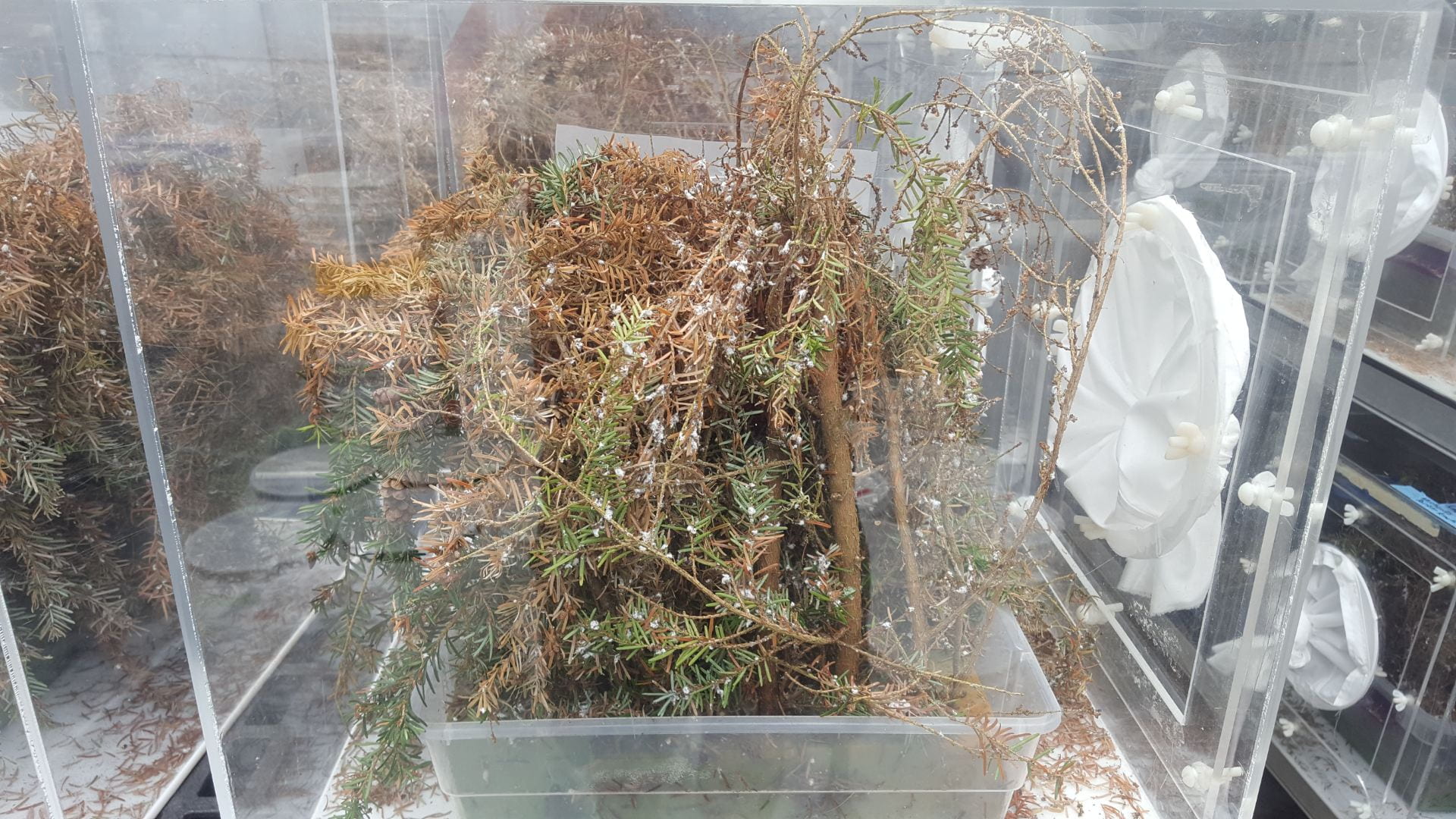Leucotaraxis Silver Flies
Our lab works with two species of silver flies, Leucotaraxis argenticollis and Leucotaraxis piniperda (Diptera: Chamaemyiidae), which are abundant predators of hemlock woolly adelgid (HWA) on the West Coast. The chamaemyiids, the family to which Leucotaraxis belongs, are known for being predatory flies. In the case of Leucotaraxis, their larvae prey on the eggs of HWA throughout HWA’s spring egg-laying season. Since flies are released in the spring and feed on a different HWA life cycle stage than the first-generation-feeding Laricobius beetles, they complement our other biocontrol species by providing HWA population control during HWA’s second annual generation. Our lab releases flies collected from Pacific Northwest hemlock foliage, and is working to develop Leucotaraxis lab rearing techniques.
Silver Fly Collection and Release
We obtain silver flies by collecting hemlock foliage from the Pacific Northwest several times throughout the spring. Foliage is processed at our quarantine facility at Cornell where we can safely collect individual flies, determine their sex, and prep them for release. We release flies in groups with a mixed sex ratio to ensure reproduction in the field. We have been releasing silver flies for biocontrol since 2015, and were the first lab on the East Coast to release Leucotaraxis for HWA biocontrol.


Silver Fly Rearing Program
In 2018, our lab began working to develop techniques to rear Leucotaraxis silver flies in a lab setting. That year, we were able to rear two generations of silver flies in the lab. In 2019, our rearing experiments focused on learning more about fly maturation and reproduction. By learning more about fly mating behavior, we aim to improve rearing outcomes each year, and have greater numbers of flies for release. One aspect of mating behavior that we are specifically interested in is the time at which maximum reproduction occurs in the life of a fly. In addition to deepening our understanding of Leucotaraxis life cycles, it helps us time biocontrol releases for active reproduction in the field.
Silver Fly Overwintering and Development
Biocontrol success hinges on understanding the life histories of predators, especially when exposing them to a new environment. In the case of Leucotaraxis silver flies, we are hoping to gain new insights by closely studying fly development under different temperature conditions and learning whether flies can withstand New York’s winter temperatures. In the winter of 2019, we took silver fly pupae from our rearing experiments and kept them in a container outside throughout the winter. In the early spring, we brought the containers into the lab to check for adult fly emergence. We were excited to find adult flies in several of our overwintering treatments, so we now know that silver flies are able to survive New York winters in the pupal stage.
In 2020, we began a development study which tracks the life cycle of individual L. argenticollis and L.piniperda flies from egg to adult fly at four different temperatures in the lab. We closely monitor each temperature treatment to understand the effects of warmer or cooler conditions on timing of the flies’ life cycle stages from egg to larva to pupa and into adulthood. This experiment is ongoing.

Silver Fly Niche Separation
One challenge from working with silver flies is that our two target species, L. argenticollis and L. piniperda, are very closely related and difficult to tell apart without genetic analysis, especially with the larvae. In 2019, we began study to examine subtle differences in the life cycles between the two species and investigate niche separation. So far, we have seen differences in the timing of adult fly emergence between the two species, which improves our ability to tell flies apart as they emerge and release them with individuals of the same species. By releasing flies of the same species together, the released groups should have more mating success in the field and bolster biocontrol establishment efforts.
Silver Fly Establishment
Knowing whether or not predators are established at release sites is a critical step in the biocontrol research process. Since Leucotaraxis silver flies are so mobile, it is nearly impossible to detect them in the field following releases. This makes it difficult to confirm establishment and subsequent spread. In 2020, NYSHI began investigating the use of environmental DNA, or eDNA, to confirm HWA predator establishment in the field and understand where our releases have been successful. This information is critical for our research so that we can efficiently build up biocontrol populations and improve our program each year.

Getting Involved in Silver Fly Projects
Our lab needs to know whether our biocontrols have established and spread in New York. If they have, we need to know where and how far. We are currently looking for landowners who are willing to help us look for our biocontrols on their land. You can help by granting land access to surveyors or, if you’d like to get more hands-on, possibly by surveying yourself! Fill out our survey below to add yourself to our list of potential participating landowners:
We are also learning about HWA dynamics in New York and where to release predators to make the biggest impact. We look specifically for areas with relatively healthy hemlock trees and dense HWA populations for ideal release sites. The best way to help us find biocontrol release sites is by joining our HWA Hunters survey team:
Other ways to Contribute
HWA Phenology
Our HWA Phenology Project aims to better understand the timing of HWA’s major life stages across climate and temperature gradients in New York, especially when it applies to biocontrol releases. Our silver flies are released when HWA is actively laying eggs, so our phenology volunteers act as our eyes in the field, alerting us to when HWA egg-laying is taking places in their area so that we may release silver flies. Learn more about the HWA Phenology Project here.
